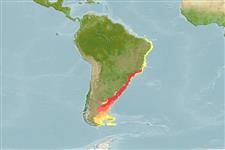Environment: milieu / climate zone / depth range / distribution range
Ecologia
marino benthopelagico; distribuzione batimetrica 15 - 135 m (Ref. 27363). Subtropical
Southwest Atlantic: Espírito Santo, Brazil (Ref. 57756) to northern Argentina.
Length at first maturity / Size / Peso / Age
Maturity: Lm 14.1 range ? - ? cm
Max length : 19.5 cm TL maschio/sesso non determinato; (Ref. 116029)
Short description
Chiavi di identificazione | Morfologia | Morfometria
Spine dorsali (totale) : 10; Raggi dorsali molli (totale) : 13; Spine anali: 3; Raggi anali molli: 7. Third spine of dorsal fin filamentous. Body light brownish dorsally, silvery ventrally. Two dark purplish broad bands on body; anterior band running from anterior part of spinous dorsal base to belly, posterior band from anterior part of soft dorsal base to posterior anal fin base. Two indistinct broad bands present posteriorly on head and caudal peduncle. Each fin pale brownish; tips of pelvic and anal fins and lower part of caudal fin slightly blackish (Ref. 27363).
Life cycle and mating behavior
Maturità | Riproduzione | Deposizione | Uova | Fecundity | Larve
Figueiredo, J.L. and N.A. Menezes, 1980. Manual de peixes marinhos do sudeste do Brasil. III. Teleostei (2). Museu de Zoologia, Universidade de São Paulo. Brasil. 90 p. (Ref. 9050)
IUCN Red List Status (Ref. 130435: Version 2024-2)
Threat to humans
Harmless
Human uses
Pesca: di nessun interesse
Strumenti
Special reports
Download XML
Fonti Internet
Estimates based on models
Preferred temperature (Ref.
123201): 7.5 - 21.7, mean 13.2 °C (based on 137 cells).
Phylogenetic diversity index (Ref.
82804): PD
50 = 1.0000 [Uniqueness, from 0.5 = low to 2.0 = high].
Bayesian length-weight: a=0.01072 (0.00888 - 0.01293), b=3.07 (3.02 - 3.12), in cm total length, based on LWR estimates for this species (Ref.
93245).
Trophic level (Ref.
69278): 3.7 ±0.5 se; based on size and trophs of closest relatives
Generation time: 3.3 ( na - na) years. Estimated as median ln(3)/K based on 2
growth studies.
Resilienza (Ref.
120179): Alto, tempo minimo di raddoppiamento della popolazione meno di 15 mesi (Preliminary K or Fecundity.).
Fishing Vulnerability (Ref.
59153): Low vulnerability (22 of 100).
Nutrients (Ref.
124155): Calcium = 95.1 [33.5, 203.5] mg/100g; Iron = 0.949 [0.468, 1.873] mg/100g; Protein = 17.8 [16.0, 19.6] %; Omega3 = 0.461 [0.256, 0.823] g/100g; Selenium = 27.1 [13.2, 56.2] μg/100g; VitaminA = 29.1 [8.4, 112.8] μg/100g; Zinc = 0.908 [0.605, 1.386] mg/100g (wet weight);
